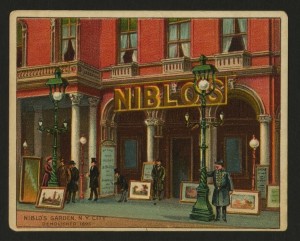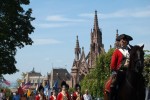 Party like it’s 1865 at Niblo’s Pleasure Garden, with a Victorian circus, vaudeville show including fire eaters and contortionists, and a picnic, in Brooklyn.
Party like it’s 1865 at Niblo’s Pleasure Garden, with a Victorian circus, vaudeville show including fire eaters and contortionists, and a picnic, in Brooklyn.
It’s the annual old-fashioned extravaganza at Green-Wood Cemetery celebrating “permanent resident” William Niblo (1789–1878), the theatrical empresario whose Niblo’s Garden was the Radio City Music Hall of its day.
On Saturday, July 17, 2016, Green-Wood’s park-like grounds will transform into a 19th-century pleasure garden and theater at the site of Niblo’s grand mausoleum, with entertainment curated by Bindlestiff Circus, a vaudeville and performing arts powerhouse. The outdoor performances, following an old-fashioned twilight picnic, will have the 19th-century flair of Niblo’s theater.
Guests are encouraged to bring blankets, picnic dinners and beverages as they step back in time with author, historian and Niblo expert Ben Feldman. After the show, Niblo’s mausoleum will be open for candlelit exploring.
WHEN: Saturday, July 17, 2016; 7PM to 10PM.
- Arrive early and take a tour of Green-Wood, to visit some of its famous residents. They include composer Leonard Bernstein, stained glass genius Louis Comfort Tiffany, and Charles Ebbetts, who owned the beloved Brooklyn Dodgers, who played in Ebbetts Field.
WHERE: Green-Wood – Meet inside the main gate (25th Street at 5th Avenue, Brooklyn)
COST: $37 ($32 for members of the Green-Wood Historic Fund and the Brooklyn Historical Society). To find out more information or to make online reservations, call 718-210-3080. Reservations are recommended.
The backstory: William Niblo often visited his Green-Wood mausoleum before he moved there permanently. Niblo’s Garden featured acrobats, vaudeville, dramas, musical concerts, and operas and was the premier destination of its time for entertainment in New York City. Niblo’s was the site of America’s first piece of musical theater. The fashionable theater-garden, located in Manhattan on Broadway between Prince and Crosby in what is now fashionable Soho, seated 3,200 persons. It was demolished in 1895.
Interesting reads
- Casinos Not On Gamstop
- Casinos Not On Gamstop
- Non Gamstop Casinos
- Casinos Not On Gamstop
- Non Gamstop Casino
- Online Casinos
- Non Gamstop Casino Sites UK
- UK Casino Not On Gamstop
- Slots Not On Gamstop
- Non Gamstop Casino Sites UK
- Slots Not On Gamstop
- Non Gamstop Casinos UK
- Non Gamstop Casinos
- Migliori Siti Casino Non Aams
- I Migliori Casino Non Aams
- Non Gamstop Casino
- Casino En Ligne
- Casinos En Ligne
- Sites Not On Gamstop
- Non Gamstop Casino UK
- Non Gamstop Casinos
- UK Online Casinos Not On Gamstop
- Sites Not On Gamstop



